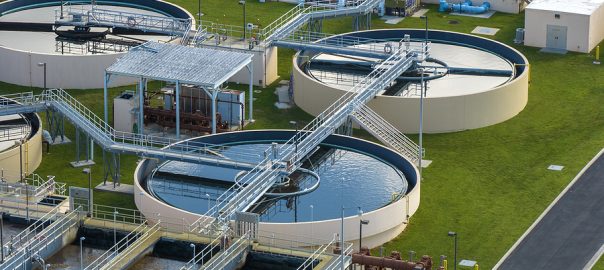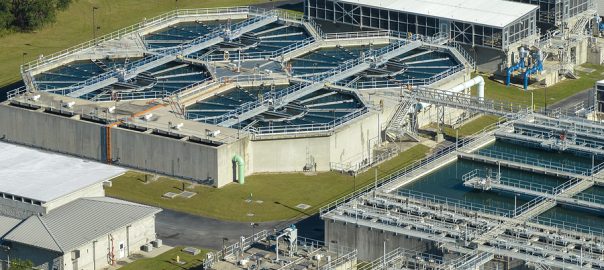
Any wastewater treatment plant will deal with sludge on a daily basis. Sludge is a semi-solid material resulting from wastewater treatment, water treatment, and other industrial processes. When it comes to wastewater treatment, sludge is often made up of fecal matter, food particles, microorganisms, and inorganic solids from things like medications people take or toilet paper pulp.
As part of the wastewater treatment process, sludge needs to be screened. The more that’s removed, the better it is for the remaining processes. Sludge screening systems are the key to removing as much sludge as possible before the other sewage sludge treatment steps.
What Does a Sludge Screening System Do?
A sludge screening system is the first step in removing solids from wastewater as it comes in from a sewer or is hauled in by trucks from residential septic systems. The screens can remove items that never should have been flushed, such as baby wipes or plastic wrappers, and help remove fats, oil, and grease (FOG), hard food particles like corn, bones, and pieces of nuts. Hair is another issue as it goes down the drain in a shower, bath, or sink and ends up in the wastewater.
These solids are removed by pumping the sludge through fine screens. Sludge is washed and compacted to remove any excess water. When the compacted sludge has been processed, It’s moved to another area for composting or further processing. Eventually, it can be used for fertilizer once it’s composted and mixed with lime, if needed, or incinerated to convert it to a fine ash that’s added to a landfill.
What Are the Benefits of Sludge Screening?
If sludge isn’t removed, it makes it harder to clean wastewater for release to a river, pond, lake, or ocean. Sludge contains phosphorus, and phosphorus feeds algal blooms in water. In a lake, algal blooms can impact the health of wildlife and aquatic animals.
Sludge can also create clogs in pipes. That’s not ideal as it can slow or stop wastewater’s movement from one area to the next. It can lead to disastrous and costly overflows or backups. Pressure from a clog can damage pumps and valves, so sludge screening helps prevent damage and emergency repairs.
Digestion that takes place during sludge treatment is handled with or without oxygen. Anaerobic is the form that uses oxygen. It’s more affordable and helps create biogas that can be used for heating and electricity. The biogas resulting from anaerobic digestion can also be converted into biomethane for use in the natural gas grid or fuel for certain vehicles.
You can also take sludge and mix it with lime to compost it. Once it’s composted, it can be used as a fertilizer. Sludge can also be incinerated to ash and added to a landfill. It creates a new way to use materials that could otherwise become a health risk in that community.
What Can Impact Sludge Screening?
What impacts sludge screening? Your wastewater treatment plant’s flow rates impact it. If the flow rate is faster than a screen handles, there are going to be problems. You need to have screens that are equipped for your highest flow rate.
The screen sizes also impact how well your system works. If the screen is too fine, it may take too long to process things. If it’s too wide, you might not effectively capture as much sludge as you were hoping.
The contents of the sludge coming into your treatment plant also impact sludge screening. If you live in an area with a lot of restaurants, the sludge coming into your plant may have more food particles and FOG than a plant with nothing more than residential homes.
How Do You Choose the Best Sludge Screening System For Your Wastewater Treatment Plant?
How are you supposed to choose? It’s going to require you to consider a few factors. First, what are your flow rates, and what are the solids usually composed of? Do you end up with more paper pulp than food waste or more FOG than other areas?
You don’t want a sludge screening system that leads to head loss. Head loss is a situation where pressure in a pipe decreases due to friction. You need to avoid that when possible.
Do you have a large maintenance team or do you need a system that takes care of itself for the most part? With a small maintenance crew or maybe just one maintenance worker, you should consider a low-maintenance system.
Screens usually need to have the chains inspected and tension adjusted when needed, bearings need to be greased, solenoid valves may need adjustments, and a periodic inspection is important. It’s always a good idea to check fasteners and make sure the vibrations of the machine haven’t loosened any connectors. If you can get a system that is above water vs. below water, these maintenance tasks are easier to manage.
What Are the Different Types of Sludge Screening Systems?
Lakeside Equipment offers a variety of Raptor® screening products for grease traps, industrial wastewater, scum, sludge, and wastewater. Our options include:
FalconRake Bar Screen: Stainless steel, corrosion-resistant construction that requires minimal headroom. This system is a low-maintenance option where bars travel up through the incoming wastewater and over the arm in a continual loop. As bars hit the top of the arm, the sludge drops to a container and the fluids drop through the wastewater screen to move to the next step in processing.
Fine Screen: The Fine Screen uses rotating rake teeth to get in between the screen’s bars to keep pushing sludge through these options. While the sludge is removed, it’s also dewatered and washed to remove organic materials. The sludge is drier and weighs less.
Micro Strainer: For lower volumes, a Micro Strainer may be ideal. It has a thicker screening basket and transport and polymer bearings to extend the equipment’s life. It’s made from corrosion-resistant stainless steel. This four-in-one system has screens to filter and remove solids, a washing system, a compactor, and a dewaterer to get as much wastewater out of the sludge as possible before moving it to the next step. The sludge ends up in a barrel.
Multi-Rake Bar Screen: A multi-rake bar screen looks like a big ladder with wide rungs that are controlled by a drive assembly. Rakes capture the sludge and bring it up to the top where the sludge is collected and pushed to a container for processing while wastewater drops into the trough to continue through the wastewater treatment process.
Rotary Strainer Screen: Wastewater comes into a cylinder and water drops through the rotating wire screen cylinder with the sludge removed using an auto-cleaning blade as the solid sludge passes through a discharge suit.
Rotating Drum Screen: A rotating drum screen is ideal for smaller particles, so it’s typically used more to remove scum from wastewater.
Ask a professional for advice. Wastewater treatment equipment specialists can talk about your current system, what you hope to achieve, and work on the best way to upgrade your wastewater equipment to get the best performance possible. Our team at Lakeside Equipment is happy to go over the different sludge screens available and what the benefits are for each one.





